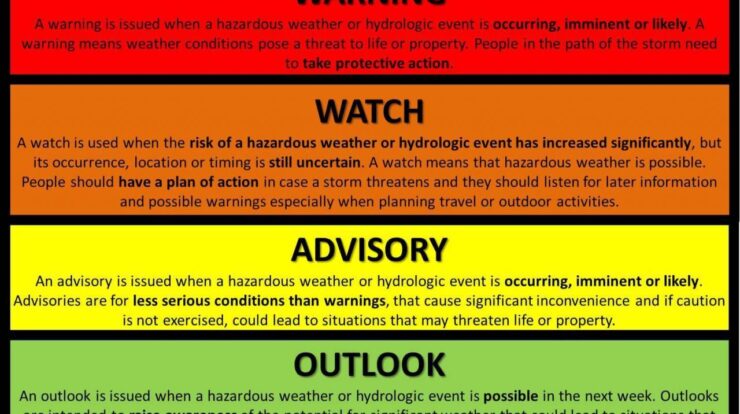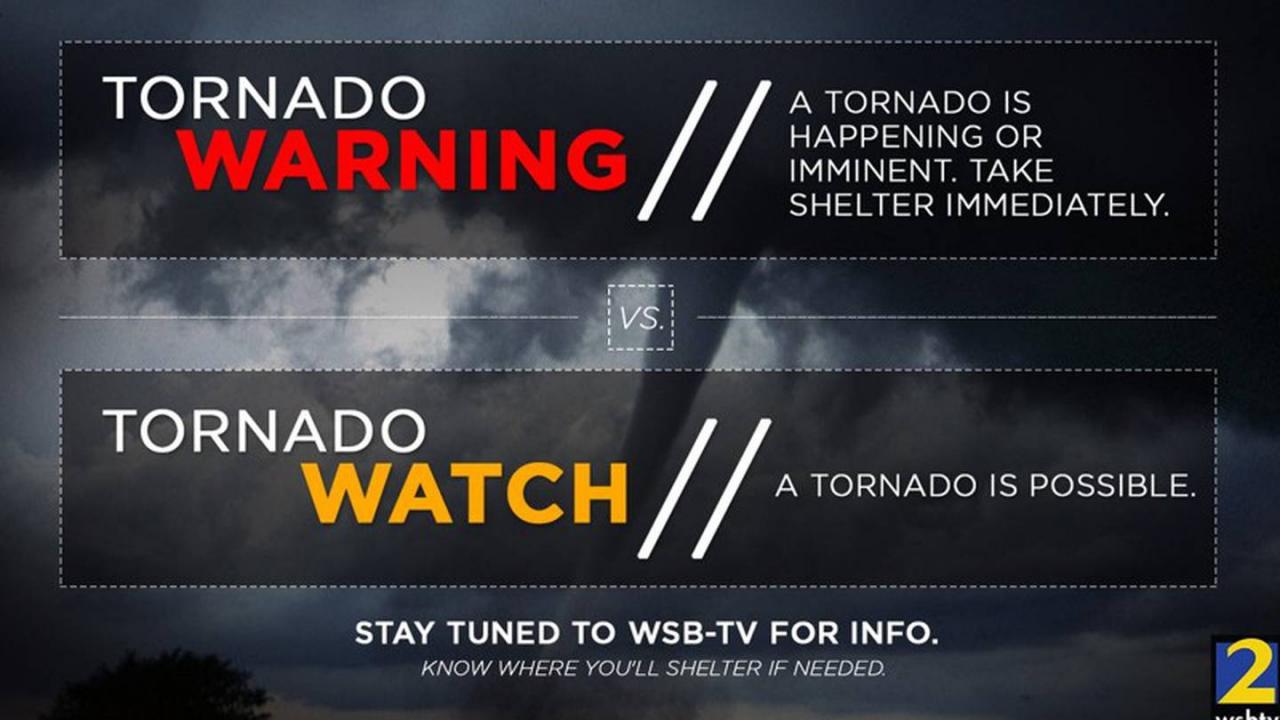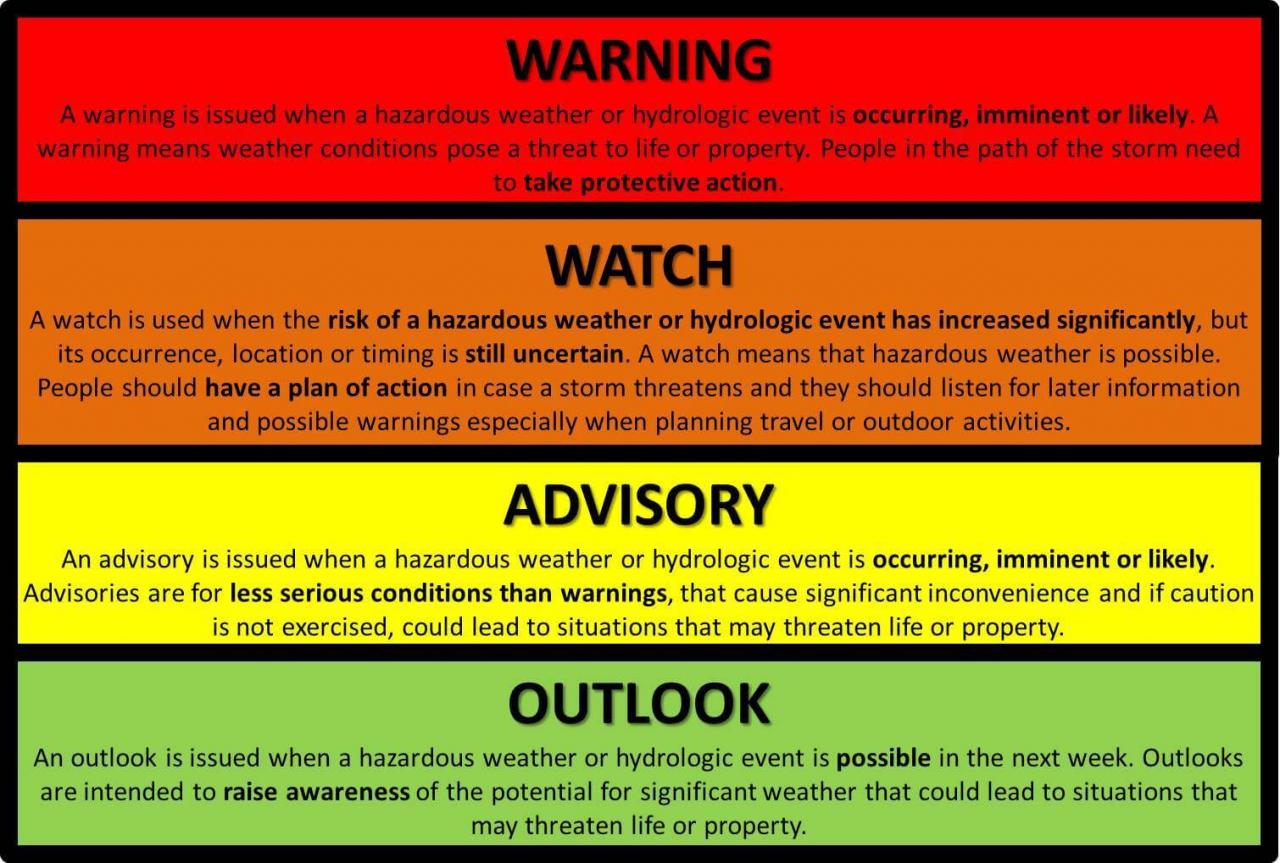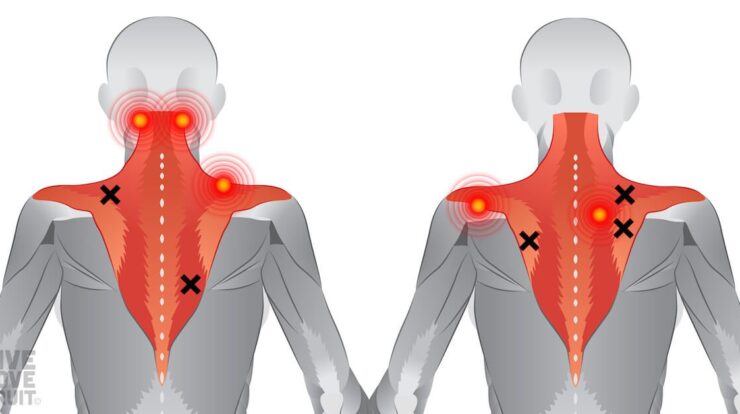
Is a watch or warning worse – When it comes to emergency preparedness, timely and accurate information is crucial. Watches and warnings are two distinct types of alerts that convey different levels of urgency and potential danger. Understanding the nuances between a watch and a warning can help individuals and organizations make informed decisions and take appropriate actions to safeguard lives and property.
Watches indicate that conditions are favorable for a hazardous event to develop or occur, while warnings signal that the event is imminent or already happening. The severity of the situation, the potential impact on affected areas, and the recommended response measures vary depending on whether a watch or warning is issued.
Watches and Warnings: Understanding the Differences and Their Impact

In the realm of emergency preparedness, the terms “watch” and “warning” play a crucial role in alerting the public to potential hazards and guiding their response. While often used interchangeably, these terms have distinct meanings and implications.
Definition of Watch and Warning
A watchis issued when conditions are favorable for a hazard to develop, but its occurrence is not imminent or certain. It serves as a heads-up, providing ample time for individuals and organizations to prepare and take precautionary measures.
In contrast, a warningis issued when a hazard is imminent or has already occurred. It signifies that immediate action is necessary to protect life and property.
Examples of Watches and Warnings
- Watch:A tornado watch is issued when conditions are favorable for tornadoes to develop, but none have been spotted or reported.
- Warning:A tornado warning is issued when a tornado has been spotted or indicated by radar, and immediate action is required.
Impact of a Watch or Warning
The impact of a watch or warning can vary depending on the severity of the hazard and the preparedness of the community.
- Individuals:Watches and warnings provide individuals with critical information to make informed decisions about their safety and well-being.
- Communities:Watches and warnings facilitate coordination among emergency responders, enabling them to mobilize resources and deploy personnel to affected areas.
- Organizations:Businesses and institutions can use watches and warnings to implement contingency plans, evacuate employees, and protect assets.
Factors to Consider When Determining Severity
Determining the severity of a situation and issuing an appropriate watch or warning involves considering several factors:
- Type of hazard:Different hazards pose varying levels of risk, requiring different levels of response.
- Magnitude of the hazard:The intensity and scale of the hazard, such as wind speed or flood depth, determines the potential impact.
- Probability of occurrence:The likelihood of the hazard actually occurring, based on historical data and current conditions.
- Vulnerability of the population:The number of people and infrastructure potentially affected by the hazard.
Communication of Watches and Warnings
Effective communication of watches and warnings is essential to ensure timely and appropriate responses. Various methods are used:
- Emergency alerts:Government agencies issue emergency alerts through mobile phones, TV, and radio broadcasts.
- Social media:Official agencies and news organizations share information through social media platforms.
- Sirens and public address systems:Local authorities use sirens and public address systems to alert communities of imminent danger.
Response to Watches and Warnings
Responding appropriately to watches and warnings is crucial for minimizing risks.
- Watches:During a watch, stay informed about the developing situation, monitor weather forecasts, and prepare an emergency plan.
- Warnings:When a warning is issued, take immediate action to protect yourself and others. Follow instructions from authorities, seek shelter, or evacuate if necessary.
Comparison of Watches and Warnings
| Characteristic | Watch | Warning |
|---|---|---|
| Definition | Favorable conditions for a hazard | Imminent or ongoing hazard |
| Purpose | Early warning and preparation | Immediate action required |
| Severity | Potential hazard | Imminent or actual danger |
| Response | Prepare and monitor | Immediate action to protect life and property |
Case Studies, Is a watch or warning worse
Numerous real-world events demonstrate the effectiveness of watches and warnings in mitigating risks:
- Hurricane Katrina:The National Hurricane Center’s timely warnings enabled many residents to evacuate before the storm made landfall.
- Fukushima Daiichi nuclear disaster:Despite warnings of a potential tsunami, the power plant operators failed to respond adequately, resulting in a catastrophic disaster.
Best Practices for Watches and Warnings
Best practices for issuing and responding to watches and warnings include:
- Clear and timely communication:Use concise and understandable language, and disseminate information through multiple channels.
- Coordination and collaboration:Foster collaboration among emergency responders, government agencies, and community organizations.
- Public education and outreach:Engage the public in disaster preparedness and response training.
Final Conclusion

Navigating the complexities of watches and warnings requires a clear understanding of their definitions, purpose, and implications. By staying informed, adhering to official guidance, and taking proactive steps, individuals and communities can enhance their resilience to emergencies and mitigate potential risks.
Expert Answers: Is A Watch Or Warning Worse
What is the difference between a watch and a warning?
A watch indicates that conditions are favorable for a hazardous event to develop or occur, while a warning signals that the event is imminent or already happening.
What factors determine the severity of a watch or warning?
Factors such as the type of hazard, the magnitude of the event, the potential impact on affected areas, and the availability of resources influence the severity of a watch or warning.
How should individuals respond to a watch or warning?
Individuals should stay informed, follow official guidance, and take proactive steps to prepare for the potential hazard, such as gathering emergency supplies, securing property, and identifying evacuation routes.






